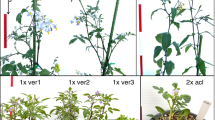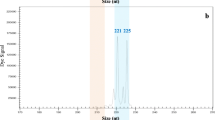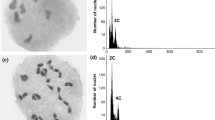Summary
A high gene frequency for ps (parallel spindles) is expected in cultivated tetraploid potatoes, S. tuberosum Group Tuberosum, if 2n pollen produced by ancestral diploid plants which were psps was involved in the origin and evolution of the potato. Fifty-six North American cultivars (varieties and advanced selections) were pollinated by diploid clones, either W 5295.7 or W 5337.3 which are homozygous recessive for ps. The segregation ratios in regard to 2n pollen production in derived tetraploid progenies, from 4x×2x crosses, reveal the genotype of ps in the cultivars. Microsporogenesis of 2n pollen producing 4x progeny was observed to avoid an overestimation of the frequency of 2n pollen producing plants due to mechanisms other than parallel spindles. More than 50% of the 56 cultivars are simplex (Pspspsps), since in each of these cultivars about 50% of their progeny produced 2n pollen. The ps gene frequency in the 56 cultivars was estimated as high as 0.69. The high frequency of ps in the tetraploid cultivars clearly supports the hypothesis that 2n pollen produced by plants homozygous recessive for ps have been involved in the origin of cultivated tetraploid potatoes, since a higher frequency of ps in the tetraploid than in the ancestral diploid population can be expected from sexual polyploidization but not from somatic doubling. The importance of meiotic mutants such as ps for the successful evolution of polysomic polyploids is emphasized.
Similar content being viewed by others
Literature
Camadro, E.L.; Peloquin, S.J. (1980): The occurrence and frequence of 2n pollen in three diploid Solanums from northwest Argentina. Theor. Appl. Genet. 56, 11–15
den Nijs, T.P.M.; Peloquin, S.J. (1977a): 2n gametes in potato species and their function in sexual polyploidization. Euphytica 26, 585–600
den Nijs, T.P.M.; Peloquin, S.J. (1977b): Polyploid evolution via 2n gametes. Amer. Potato J. 54, 377–386
Hanneman, R.E., jr.; Peloquin, S.J. (1968): Ploidy level of progeny from diploid-tetraploid crosses in the potato. Amer. Potato J. 45, 255–261
Harlan, J.R.; de Wet, J.M.J. (1975): On O. Winge and a prayer: the origins of polyploidy. Bot. Rev. 41, 361–390
Hawkes, J.G. (1979): Evolution and polyploidy in potato species. In: The biology and taxonomy of the Solanaceae (ed. Hawkes, J.G.). Linnean Soc. Symp. Ser. 7, 637–646
Iwanaga, M.; Peloquin, S.J. (1979): Synaptic mutant affecting only megasporogenesis in potatoes. J. Hered. 70, 385–389
Iwanaga, M.; Peloquin, S.J. (1980): FDR and SDR 2n egg formation in diploid potatoes. Amer. Potato J. 57, 483
Marks, G.E. (1954): An acetocarmine glycerol jelly for use in pollen fertility counts. Stain Technol. 29, 277
Mendiburu, A.O. (1971): Significance of 2n gametes in potato breeding and genetics. Ph.D. Thesis, Univers. Wisconsin, Madison.
Mendiburu, A.O.; Peloquin, S.J. (1977): Bilateral sexual polyploidization in potatoes. Euphytica 26, 573–583
Mok, D.W.S. (1975): Cytology, genetics and breeding value of 2n gametes in diploid potatoes. Ph.D. Thesis, Univers. Wisconsin, Madison.
Mok, D.W.S.; Peloquin, S.J. (1975): Three mechanisms of 2n pollen formation in diploid potatoes. Can. J. Genet. Cytol. 17, 217–225
Mok, D.W.S.; Peloquin, S.J.; Tarn, T.R. (1975): Cytology of potato triploids producing 2n pollen. Amer. Potato J. 52, 171–174
Quinn, A.A.; Mok, D.W.S.; Peloquin, S.J. (1974): Distribution and significance of diplandroids among the diploid Solanums. Amer. Potato J. 51, 16–21
Riley, R. (1960): The diploidization of polyploid wheat. Heredity 15, 407–429
Riley, R.; Chapman, V. (1958): Genetic control of the cytological diploid behaviour of hexaploid wheat. Nature 182, 713–715
Sears, E.R.; Okamoto, M. (1958): Intergenomic chromosome relationships in hexaploid wheat. Proc. X Int. Congr. Genet. 2, 258–259
Simon, P.W.; Peloquin, S.J. (1976): Pollen vigor as a function of mode of 2n gamete formation in potatoes. J. Hered. 67, 204–208
Author information
Authors and Affiliations
Additional information
Communicated by H. F. Linskens
Rights and permissions
About this article
Cite this article
Iwanaga, M., Peloquin, S.J. Origin and evolution of cultivated tetraploid potatoes via 2n gametes. Theoret. Appl. Genetics 61, 161–169 (1982). https://doi.org/10.1007/BF00273885
Received:
Issue Date:
DOI: https://doi.org/10.1007/BF00273885




